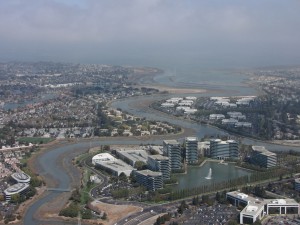But what, specifically, does Mount think Silicon Valley companies should be doing to prepare for the coming floods? He acknowledged that a lot of companies have “distributed networks” with key data backed up in other parts of the country. But he thinks the companies should do a lot more. Putting computer servers and other critical equipment on the second floor, for example. Mount pointed out that Sandy knocked out backup generators in the basements of some hospitals.
And what happens if employees can’t get to work because the roads are under water, they can’t telecommute because the power is out, or they can’t even use their offices because damage to sewage treatment plants have rendered the restrooms inoperable?
Mount is calling on Silicon Valley companies to chip in for flood defense of the whole region. He envisions three essential projects:
- Building seawalls and levees. The idea here is pretty simple: you build a physical barrier that keeps the water from sloshing into buildings and over roads – sort of like the famous Dutch dikes.
- Moving sewage treatment plants. A lot of the plants are located on low ground so that they could take advantage of gravity to pull water in. That’s a bad idea because these areas will be the first to flood, making the plants useless and potentially spreading sewage everywhere.
- Restoring wetlands. The marshy places along the coasts can absorb water like a sponge, then release it slowly so creeks and culverts don’t overflow. The plants that grow there can break the impact of waves sweeping inland. And if the sea levels don’t rise too fast, the tidal marshes can actually rise with them. The plants use silt to build up the marsh and keep themselves above water.
Regarding wetlands, the conservationist group Save the Bay seconds the motion. Wetlands are not just good for flood control, said David Lewis, the organization’s executive director. “They’re just about the most biologically rich areas in the planet.” And they may sequester carbon as well, slowing down the phenomenon behind global warming.
Unlike Mount, Lewis said a lot of progress is being made toward restoring Bay Area wetlands. “Actually it has been proceeding fairly rapidly in areas where it was easy to do,” he said.
Progress So Far
For example, salt ponds in Hayward around the San Mateo Bridge have already been restored to tidal marshes.
And work to restore the flood plain for the Napa River stood the test of last week’s storm. The river has flooded 21 times in the past century but flowed cheerfully inside its banks over the weekend as the rain drenched the countryside.
Lewis agreed that Silicon Valley is still at high risk. Alviso and parts of San Jose are below sea level, for example. The Oracle Campus in Redwood Shores is on land that was once tidal marshes. Much of the valley has actually gotten lower in recent decades because groundwater was pumped out for municipal supplies.
For a perspective on what Silicon Valley companies are doing – from someone willing to talk about it – Lewis referred me to Mike Mielke, vice president for environment programs and policy at the Silicon Valley Leadership Group. The SVLG counts among its members Cisco, Google, Lockheed and Oracle. Altogether the companies in the group have three trillion dollars in annual revenue.
“I’m not aware of individual actions,” Mielke told me when I asked what these companies are doing to save themselves and their neighbors from the coming deluge. “I have not gotten a lot of feedback from individual companies, though I have reached out to them.”
But collectively the companies supported Measure B in Santa Clara, which renewed a property tax to pay for clean water and some flood protections.
And the group has signed onto a fundraising effort with Sen. Dianne Feinstein and the Gordon and Betty Moore Foundation, aiming to raise $1 billion for new levees and wetlands restoration.
Mielke said the organizers hope to get the federal government to chip in a third, the state government to chip in another third and local government to come up with the remaining third. In other words, the SVLG feels that taxpayers should foot the bill.
I asked if a few companies like Google couldn’t get together and just, you know, write a few checks.
But Mielke turns Mount’s argument about infrastructure on its head. Just because these companies have a lot of money doesn't mean they have the greatest obligation to pay for flood protection, he said. “It’s not just the individual companies that are at risk."
So much for soaking the rich.
